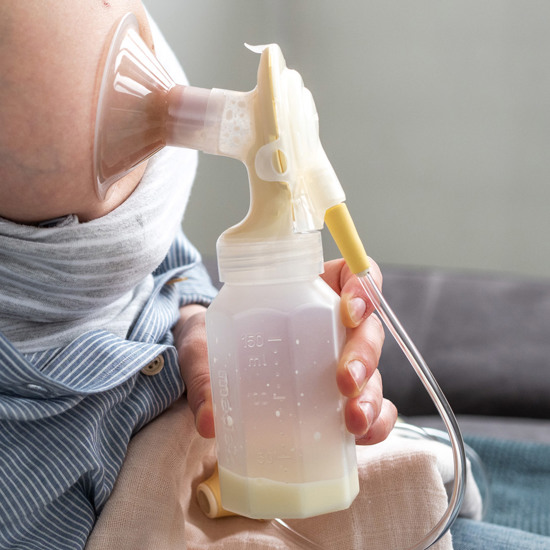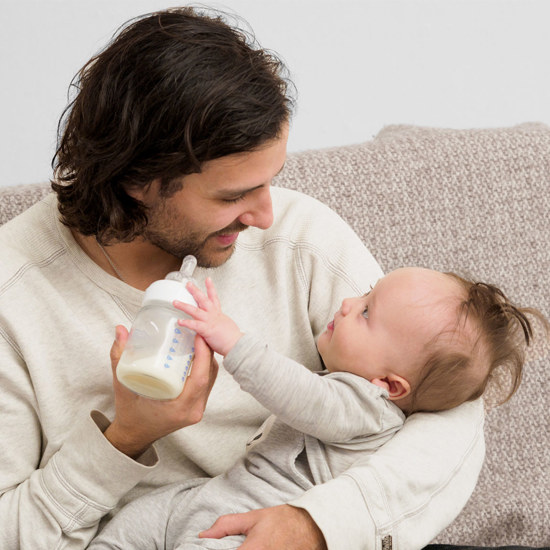How do I cup-feed my newborn?
When cup-feeding, let baby set the pace. Choose a small cup. Hold baby semi-upright in the crook of your arm, or on your lap facing you, while you support his neck. Your baby will naturally bring his hands to his mouth when about to drink. You should offer baby the milk; don’t pour it into his mouth. Place the cup against baby's lower lip. Tilt the cup until the milk just touches baby's upper lip. Wait for him to respond and sip the milk. When baby starts to swallow, watch carefully. Take a break if your baby needs one, for example, if he stops drinking, frets or turns away. Cup-feeding can be helpful before breastfeeding is established.
How should I plan bottle-feeds?
You should feed your baby when she shows signs of being hungry. Use clean bottles and carefully prepared infant formula or breast milk. The milk should feel lukewarm against your wrist. With clean hands, check that the bottle teat is intact. Use teats with as few holes as possible, so that the baby has to work to get the milk. Try to find somewhere quiet, without too many distractions. Get yourselves comfortable. Hold baby close, semi-upright in the crook of your arm. Make eye contact and talk to your baby. Your baby will give you many cues during a feed. Keep hot water and drinks (tea/coffee) out of baby's reach. While feeding, your baby will need closeness and soothing.
How do I bottle-feed my baby?
Hold baby close, semi-upright in the crook of your arm. Make eye contact and talk to your baby.
The bottle teat should tickle baby's upper lip and should be offered when baby opens wide. Hold the bottle horizontal. With slow, paced feeding, baby will have time to start feeling full and satisfy her natural sucking urge. It should be easy to take breaks. During the feeding breaks, the bottle teat should touch baby’s upper lip, as a sign that the milk is there when she’s ready again. Signs that baby is full or needs a break are stopping drinking, turning her head away, splayed fingers, difficulty swallowing or pushing the bottle away. Your baby will decide when to stop feeding, even if the bottle is not empty. Many infants need to burp both during and after feeds.

Breastfeeding aids
Learn about manually expressing and pumping breast milk.
Illustration: Ole Walter Jacobsen - Helsedirektoratet

Infant formula
Questions, answers and videos about formula.
Illustration: Ole Walter Jacobsen - Helsedirektoratet
How to use a supplemental nursing system (SNS)
A supplemental nursing system (SNS) consists of a tube taped to the breast at one end, and the other end inserted in a container of milk. You can make one yourself (watch the video) or buy the equipment from a pharmacy. Fill the clean container with milk. Attach the tubes to the notches on the lid of the container to prevent the milk from running out. Tape the tube to your breast so that the end is at the tip of your nipple. Baby latches wide over both the areola and the tube. Try shaping your breast to make it easier for baby to take a deep latch. Baby first receives the milk you have in your breast. When your breast is nearly drained, open the milk in the SNS by releasing the tube from the notch in the lid. Baby can now feed additional milk from the SNS.
How to use a home-made supplemental nursing system (SNS)
Before purchasing a supplemental nursing system (SNS), you can try making one yourself. You will need a baby feeding bottle and a gastric feeding tube. Ask at the health centre if they can help you with a feeding tube (single-use only). Take care to have clean hands and clean, sterilised equipment. Snip a small hole in the bottle teat, just enough to thread the tube through it. The thick end of the tube goes inside the bottle. Fill the bottle with breast milk or formula and attach the teat. Tape the tube to your breast. The end stops at the tip of your nipple. Baby latches wide over both the areola and the tube. Shape your breast to make it easier for baby to get a deep latch. Kink the tube to block the milk flow. This way, baby will feed from your breast first. As your breast empties, release the kink. Baby can now feed from the SNS.
Why use a supplemental nursing system (SNS)?
A supplemental nursing system (SNS) can be helpful if you want to breastfeed as much as possible but are producing minimal or no milk. With a SNS, baby gets extra milk (breastmilk or formula) while suckling on your breast. The breastfeeding may stimulate your milk production when your baby suckles. During the first weeks of breastfeeding, it may be wise to avoid bottle-feeding. This is because the teat may cause what is called ‘nipple confusion’. Feeding from a breast versus a bottle teat requires a different suckling technique. Thus a SNS may be a good alternative to bottle-feeding. Breastfeeding with a SNS can provide extra closeness and skin contact. This may aid mother-baby bonding and is one reason why some adoptive mothers are using a SNS.